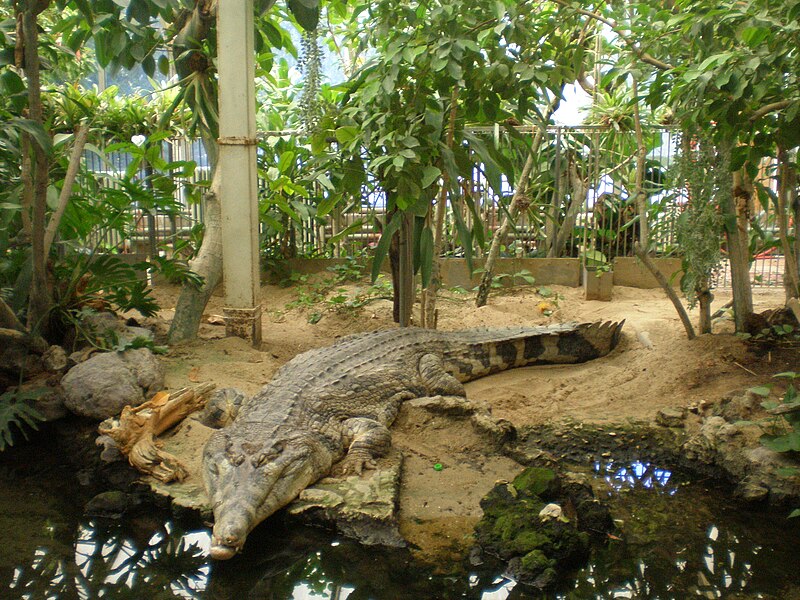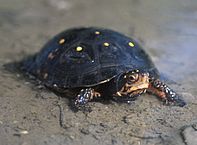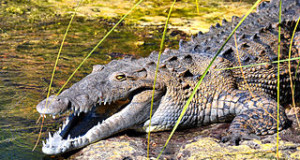 I find it difficult to express just how fortunate I’ve been in having had the chance to work with 12 Crocodilian species in the wild and captivity. Breeding Dwarf Caimans, wrestling Orinoco Crocodiles into boats, getting up close and personal to Gomek (a giant, now famous Salt Water Croc), rearing Indian Gharials…these and many other experiences remain etched in my memory. One species in particular cemented my interest in the group, and remains as much a mystery today as it was when I first saw it some 40 years ago – the massive False Gharial, Tomistoma schlegelii.
I find it difficult to express just how fortunate I’ve been in having had the chance to work with 12 Crocodilian species in the wild and captivity. Breeding Dwarf Caimans, wrestling Orinoco Crocodiles into boats, getting up close and personal to Gomek (a giant, now famous Salt Water Croc), rearing Indian Gharials…these and many other experiences remain etched in my memory. One species in particular cemented my interest in the group, and remains as much a mystery today as it was when I first saw it some 40 years ago – the massive False Gharial, Tomistoma schlegelii.
A Mysterious Giant
The False Gharial, which may exceed 16 feet in length, is the least-studied of the large Crocodilians, and among the rarest. It has been bred in captivity only 3 times in the last 60 years (once at the Bronx Zoo, prior to my tenure) and few US zoos exhibit them today; 28 reside in European zoos, while South America is home to 1 specimen.
A secretive nature keeps the False Gharial shrouded in mystery. The few field studies that have been carried out (please see below) indicate that it has been exterminated from much of its range.
My Introduction to the False Gharial
During my years with the Bronx Zoo, I was lucky enough to have 4 adult False Gharials under my care, including the only proven breeders in the Western Hemisphere. They were huge beasts, the largest of which topped 600 pounds in weight. Each had been in the collection for 20-30 years when I began working with them. I clearly recall seeing these same animals when visiting the zoo as a teenager, but their increased size did not fully register until I dug out some old food cards. Upon arrival at the zoo, they were feeding upon goldfish…they now downed whole chickens without effort, and were capable of taking much larger meals!
 I was especially struck by the False Gharials’ jaws. I had previously worked with a related species, the Indian Gharial (Gavialis gangeticus). The Indian Gharial feeds primarily upon fish that are captured with uniquely-long and slender jaws. The False Gharial’s jaws are also elongated, but they are in no way slender! Up close, the massive bones and muscles that anchor these powerful weapons are readily apparent. It was easy to imagine that, as I had read in field reports, wild False Gharials regularly dined on Proboscis Monkeys and other sizable mammals.
I was especially struck by the False Gharials’ jaws. I had previously worked with a related species, the Indian Gharial (Gavialis gangeticus). The Indian Gharial feeds primarily upon fish that are captured with uniquely-long and slender jaws. The False Gharial’s jaws are also elongated, but they are in no way slender! Up close, the massive bones and muscles that anchor these powerful weapons are readily apparent. It was easy to imagine that, as I had read in field reports, wild False Gharials regularly dined on Proboscis Monkeys and other sizable mammals.
Mom Salvages my Honor…perhaps
The difference between False Gharial and Indian Gharial jaws was brought home to me when I first tried to urge a False Gharial out of my way while servicing its exhibit. With Indian Gharials, there was a chance that the jaw might be damaged if an animal struck the “croc pole” (a thick pole used to nudge crocs and keep them at a safe distance); the first time a male False Gharial hit my pole it splintered and flew out of my hands. He and his mate charged and, now unarmed, I fled out the exhibit service door.
While in retreat I noticed my mother, a long-term Bronx Zoo volunteer, pointing me out to a group of school children. Fearing I had worried her (again!), I came out from behind the exhibit. I found my mom, ever-confident in my abilities, explaining to the children that experience and training had enabled me to know just how to react in this dangerous situation. Not wishing to disillusion her or her wide-eyed audience, I did not point out that adrenaline and common sense were largely responsible for my inglorious exit!
False Gharials vs. Cuban Crocodiles
False Gharials drew me into an even more dangerous incident some years later. Seven Cuban Crocodiles (Crocodylus rhombifer) broke through a wall and invaded an exhibit housing a pair of False Gharials. I and two co-workers waded in and tried to separate the enraged combatants while also protecting one another from attack. In the ensuing two hour battle, we escaped injury and were able to separate the animals. Many bore bite wounds, but crocs have amazing immune systems, and all healed without further complications.
Transporting Crocodiles
I’ve helped to grab, tie and transport adult False Gharials on four occasions, and each experience confirmed my belief that these heavily-armored creatures are among the world’s most physically impressive reptiles. I’ve “wrestled” with other large crocs in the course of my work (please see Marsh Crocodile photo), but none battled as hard or seemed as “indestructible” as did False Gharials.
Sadly, I learned that they too have weaknesses. In time, zoos began experimenting with sedatives as a means of rendering crocodile relocations less dangerous for both keeper and kept. Unfortunately, little was known about the effects of medications designed primarily for mammals, and we lost two adult False Gharials to complications arising from the use of Ketamine.
Natural History
Although some ambitious field studies have been undertaken (please see “Further Reading”, below), we know surprisingly little of the False Gharial’s life in the wild. Unlike most large crocodilians, it is quite secretive, and dwells in habitats that are difficult to survey.
Taxonomy
The False Gharial is placed in the Order Crocodylia (25 species) and Family Crocodylidae (16 species). Recent evidence of its relationship to the Indian Gharial may lead to a reclassification in the Family Gavialidae.
Range
Once found throughout much of Southeast Asia, the False Gharial is now extinct in Thailand, Vietnam and Sulawesi. Today it survives only on the Malay Peninsula, Borneo, Sumatra and Kalimantan. In the early 2000’s, a remnant population was discovered in western Java. Additional surveys are needed (please check here http://tomistoma.org/pa/ for survey updates).
Habitat
 The False Gharial inhabits heavily-vegetated peat swamps and slow-moving “black water” rivers. There is evidence that it occasionally enters the tidal portions of certain rivers.
The False Gharial inhabits heavily-vegetated peat swamps and slow-moving “black water” rivers. There is evidence that it occasionally enters the tidal portions of certain rivers.
Diet
The long, slender jaws of young False Gharials indicate that they are fish specialists. The jaws thicken with age, allowing adults to take monkeys, small deer, birds, snakes, turtles and other creatures.
Reproduction
Females scrape together a mound of dead vegetation in which to deposit their 20-30 large eggs, but appear not to guard the nest or young. Eggs are likely lost to wild pigs, Water Monitors and other predators.
Conservation
The False Gharial is extinct in several countries and is threatened elsewhere by dam building, gold mining, incidental capture in fishing nets, and the over-harvesting of fish. Fewer than 2,500 adults are believed to remain, but accurate surveys are lacking. Fortunately, several populations are located within reserves that also shelter Orangutans and other creatures better known to the public.
The only predator of larger False Gharials appears to be the Salt Water Crocodile, Crocodylus porosus.
The False Gharial is classified as “Endangered” by the IUCN and is listed on Appendix I of CITES.
Further Reading
Fishing for Alligators in NYC’s Sewers
Field Report: False Gharials in Kalimantan
False Gharial in enclosure image referenced from wikipedia and originally posted by kennyannydenny
 That Reptile Blog – Reptile, Amphibian and Exotic Pet Care and Information
That Reptile Blog – Reptile, Amphibian and Exotic Pet Care and Information



thanks for a very interesting article. I had never heard of them beore. You print the greatest articles that I really enjoy reading. I have learned a lot from them .please keep them coming. Thanks Alison
Hi Alison,
Sorry for the delay in responding…glitch in system.; Thanks so much for the kind words, much appreciated. Best regards, Frank